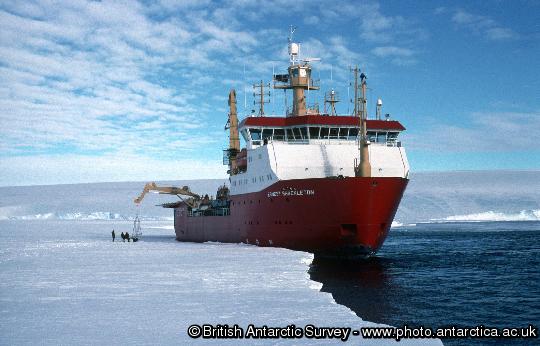
All information below adopted from BAS website: (for my personal interest)
Laboratory Space
- Dry lab, with computer flooring, work benches and all required facilities: 45 m²
- Wet lab, with stainless steel interior and all required facilities: 45 m²
- Preparations made for installing two container labs. (ISO 20 ft) with connection point to aft research deck area.
|
Research Facilities
- Telescopic crane at stern: 10 T
- ROV crane on upper deck 5 T/10 m-hydraulic and able to pick up from sea level
- Navigation information system to all lab areas
- Uncontaminated sea water supply to wet lab
- Separate HVAC for laboratories
- Slow speed and position-keeping facilities
- Track Steering and Dynamic Positioning
- 12 kHz hydrographic echo sounder - monitor in dry lab
- Preparations (hull dome) made for installation of bottom mapping system (Simrad EM 12-13 kHz)
- Sonar room with void sluice valves up to 16 inch
|
Helicopter Facilities
- Max weight of helicopter: 10 T on wheels
- Designed for Super Puma
- Diameter of deck: 18 m
- Refuelling, navigation communication and fire fighting equipment to high standards. Upper cargo hold to be used as hangar
|
Accommodation
- Mess room, day rooms, exercise facilities and sauna
- Passengers' laundry facilities
- Total capacity: 80 persons including crew
- Fully air conditioned
- Hi-fog firefighting equipment
- 37 cabins (1,2,3 and 4 berth)
- Hospital facilities
|
Electronics
- Computerised engine monitoring - ICS class
- Navigation and communication equipment to highest standards, including ECDIS, GMDSS and W1 (DnV) classification of bridge
|
Safety
- Built to the Norwegian Ship Control Rules, Solas and IMO
- Special Purpose Vessel A534(13) Resolution
- MOB-Boat. Survival suits for all personnel
- Fire monitoring and protection including Hi-fog for accommodation and foam guns for helicopter deck
- Intercom and public address system
- TV monitoring system to cover most areas of the vessel
- Safety manuals and QA operations system according to DnV
- SEP, incorporating IMO-ISM code
- Double hull construction
|
Environment
- Equipped with oily water separator, incinerator, garbage compactor and waste water treatment according to Antarctic Treaty Environmental Protocol and MARPOL
- Fuel oil storage arranged to minimise risk of accidental spills
|
Icegoing
- Proven design. Model tested in ice tank
- Inerta 160 - low resistance hull paint
- Patented propeller and rudder protection
- Machinery cooling stand-by arrangement
- De-icing in foreship and superstructure
|
Cargo Logistics
- Underdeck bale of about 3000 m³
- Container loading in forward upper hold and on forward hatch
- Plugs for 4 reader containers
- Arctic fuel in ship's fuel tanks
- Jet A-1 aviation fuel in separate tanks
- Aft hatch flush with helicopter deck (for cargo handling)
- Cargo crane - 30 T at 20 m outreach
- Decks prepared for heavy vehicles
|
Offshore Survey
- Dynamic Positioning - AUT R
- HPR tracking systems Hi Pap and 410
- Taut wire, interface to Artemis, DGPS and Fan Beam
- ROV crane 5 T at 10 m
- 12 kHz hydrographic echo sounder
- Preparations (hull dome) made for installation of bottom mapping system (Simrad EM 12-13 kHz)
- Telescopic crane at stern: 10 T
- Two separate stabilising tanks
- Offshore crane: 50 T at 10 m
|
Main Particulars
- L.o.a. 80.0 m
- L.p.p. 72.4 m
- B. mld. 17.0 m
- Draft 6.15 m
- Draft (scantl.) 6.85 m
- Deadweight (at 6.15 m) 1800 T
- Fuel oil 1380 m³
- Freshwater 165 m³
- Aviation fuel (Jet A-1) 195 m³
- Consumption: 9.5 tons/24 h at 12 knots
- Consumption: 17 tons/24 h at 14 knots (max speed)
- Endurance: about 130 days/40,000 nautical miles
|
Propulsion
- 2 x Bergen Diesel BRM 6 each 2550 kW at 720 rom
- Single screw C.P. propeller in nozzle from twin output/single output gearbox
- Azimuth thruster forward as emergency "take you home" propulsion
|
Electrical Power
- 2 x 2200 kW shaft generators
- 2 x 600 kW aux. generators
- 1 x 150 kW emergency generator
- 450 V - 60 Hz for heavy consumers
- 230 V - 60 Hz for accommodation/general use
- 120 V - 60 Hz for lab. space
- 230 V and 120 V UPS 60 Hz for lab. spaces
- 230 V and 120 V 60 Hz clean power for lab. spaces
- 230 V - 50 Hz clean power for lab. spaces
|
Internal Regulations
- Norwegian ship control rules, SOLAS, IMO and IMO A534 (13) Resolution
- (Special Purpose Vessels) MARPOL, Antarctic Treaty
- Environmental Protocol
- Canadian Arctic Pollution
- Classed for WORLD WIDE trade
|
Manouvering, navigation and communication
- The vessel is equipped to high standard including:
- Dynamic positioning and separate joystick
- Conventional back-up system in wheelhouse and crow's nest
- Three radars, two gyro compasses, RDF, helicopter homing beacon, GPS navigation system, wind sensors and log
- ECDIS digital mapping system with all equipment integrated to DnV W1 approved bridge
- Navigation echo sounder, navigation sonarm hydrographic echo sounder
- Communications to GMDSS including satcom., MF/HF and VHF intercom and hailing system
- TV-monitoring with 20 cameras
|
 留言列表
留言列表